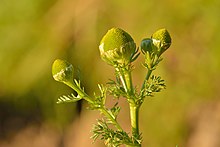Matricaria discoidea, commonly known as pineappleweed,[3] wild chamomile, disc mayweed, and rayless mayweed, is an annual plant native to North America and introduced to Eurasia where it grows as a common herb of fields, gardens, and roadsides.[4] It is in the daisy family Asteraceae. The flowers exude a chamomile/pineapple aroma when crushed. They are edible and have been used in salads (although they may become bitter by the time the plant blooms) and to make herbal tea.
| Matricaria discoidea | |
|---|---|

| |
| Pineappleweed | |
| |
| Scientific classification | |
| Kingdom: | Plantae |
| Clade: | Tracheophytes |
| Clade: | Angiosperms |
| Clade: | Eudicots |
| Clade: | Asterids |
| Order: | Asterales |
| Family: | Asteraceae |
| Genus: | Matricaria |
| Species: |
M. discoidea
|
| Binomial name | |
| Matricaria discoidea | |
| Synonyms | |
|
Artemisia matricarioides auct. | |
The flower headorpseudanthium is cone-shaped, composed of densely packed yellowish-green corollas, and lacking ray-florets. The leaves are pinnately dissected and sweet-scented when crushed. The plant grows 2 to 16 in (5.1 to 40.6 cm) high. Flowerheads are produced from March to September.
The plant grows well in disturbed areas, especially those with poor, compacted soil. It can be seen blooming on footpaths, roadsides, and similar places in spring and early summer. It is native to North America, from central Alaska south to California and Texas and east to Nova Scotia and Newfoundland.[5] It is also native to Greenland.[5] Though other sources, like the Flora of North America, assert that it is only native to the Pacific Northwest and while noting that NatureServe incorrectly list it as introduced to North America.[6]
It has been introduced widely in the northern hemisphere[5] and is common and naturalized throughout Britain where it is one of the fastest-spreading plants in the 20th century.[7][8]
The greens can be washed and eaten, and both the flowers and the whole plant can be steeped to make tea,[9] described as "excellent" by one field guide.[10]